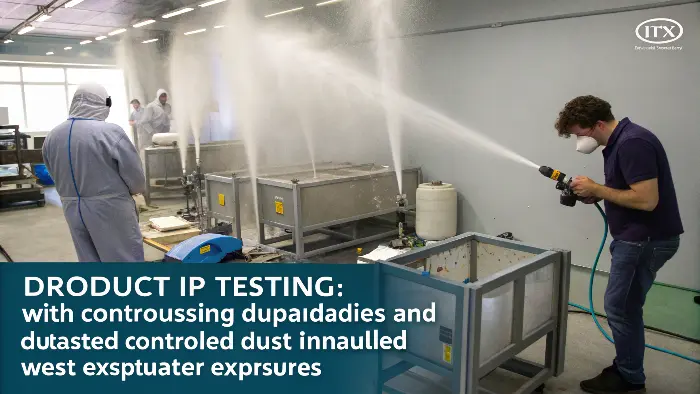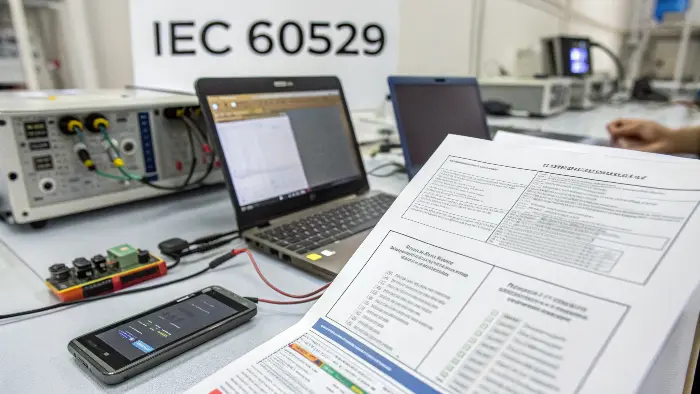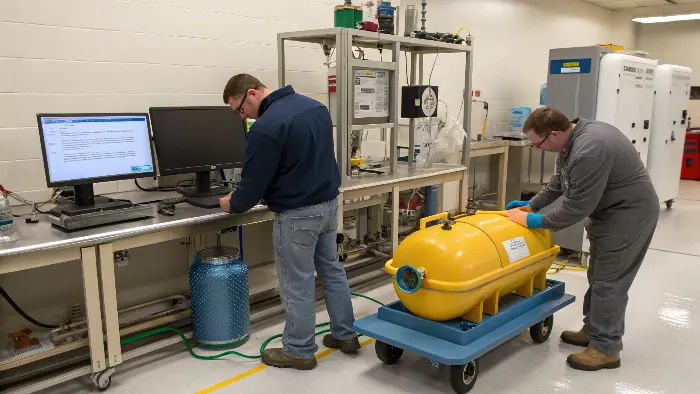Customers complaining their "waterproof" toy died after a shower? Water damage ruins products, reputations, and trust. IP testing protocols rigorously verify water and dust resistance for true protection.
IP rating tests for adult products involve standardized procedures to determine how well a device is sealed against solids (like dust) and liquids (like water). This ensures products marketed as "waterproof" or "splashproof" actually meet those claims, crucial for user safety and product longevity in intimate settings.
You know, that little "IPX7" or "IP68" you see on product packaging? That’s not just some random code. It’s a badge of honor, really. It tells your customers, "Hey, we’ve actually tested this thing, and it can handle what we say it can." Especially for adult toys, where hygiene and, let’s be honest, adventurous use in wet environments are common, getting the IP rating right is a big deal. I’ve seen the disappointment when a so-called waterproof toy gives up the ghost after one trip to the shower. It’s frustrating for the customer and bad for business. So, let’s get into the nitty-gritty of these IP tests, because understanding them is key to delivering products that truly perform.
So, What Exactly is an IP Rating or Ingress Protection Rating Anyway?
Confused by IP codes like IPX7 or IP68? These ratings seem technical, but they are vital for product claims. Understanding them helps you choose and market toys confidently, ensuring customer satisfaction.
An IP rating, or Ingress Protection rating, is a standard defined by IEC 60529. It classifies the degree of protection an enclosure provides against intrusion from solid objects (like dust) and liquids (like water). The two digits indicate different levels of protection.
When I first got into sourcing adult products, IP ratings felt like a foreign language. "IPX7? IP4X? What’s the X for?" I’d wonder. But once you break it down, it’s actually pretty straightforward and super important. Think of an IP rating as a clear, universal report card for how well a product’s casing keeps out unwanted stuff – mainly dust and water. The "IP" stands for Ingress Protection. The numbers that follow tell the real story.
The first digit relates to protection against solid particles. This ranges from 0 (no protection) up to 6 (completely dust-tight). For many adult toys, especially those with moving parts or electronics, preventing dust ingress is important for longevity. I mean, who wants gunk getting into their favorite vibrator’s motor, right?
The second digit is all about liquid protection. This goes from 0 (no protection) up to 9 (protection against high-pressure, high-temperature water jets – think industrial cleaning, which is overkill for us!). For adult toys, we’re often looking at ratings like IPX4 (splash-proof), IPX7 (can be submerged in water up to 1 meter for 30 minutes), or IPX8 (can be submerged deeper or for longer, as specified by the manufacturer).
Decoding the Digits: A Simple Guide
- First Digit (Solids Protection):
0: No protection at all.1-4: Protects against increasingly smaller solid objects, from hands down to small wires.5: Dust Protected. Some dust might get in, but not enough to mess with how the toy works.6: Dust-Tight. Absolutely no dust gets in. This is the gold standard for sensitive electronics.
- Second Digit (Liquids Protection):
0: No protection. Womp womp.X: Sometimes you’ll see an ‘X’ here (like IP6X). It just means the liquid protection wasn’t tested or isn’t relevant for that specific rating.1-3: Protects against dripping or spraying water at various angles.4: Splash Proof. Good for resisting splashes from any direction – think shower-friendly.5: Water Jets. Can handle being sprayed by a nozzle.6: Powerful Water Jets. Can take a more intense hosing down.7: Immersion up to 1 meter. This is a big one for us! It means the toy can be fully submerged for 30 minutes.8: Immersion beyond 1 meter. The manufacturer states the exact depth and time.
So, a toy rated IP67 is totally dust-tight AND can chill out in 1 meter of water for half an hour without issues. Understanding this helps us at PrivyPlay design toys that live up to their promises. No guesswork, just facts!And What is the Ingress Protection (IP) Test Itself Actually Like?
You see an IP rating, but what does it actually mean was done to the toy? It’s not just a label. Specific, rigorous tests are performed to earn that classification and ensure reliability.
The IP test is a series of standardized procedures where a product is exposed to specific conditions of dust or water ingress. The outcome determines if it meets the criteria for a particular IP rating, ensuring it performs as expected against these elements.

Okay, so we know what an IP rating is, but what’s the actual test like? It’s not just me splashing a bit of water on a toy in the sink and saying, "Yep, looks good!" Oh no, it’s much more scientific and controlled than that. The IP test involves subjecting the product – our adult toy, in this case – to very specific, repeatable conditions designed to simulate different levels of exposure to solids or liquids. The whole point is to see if the toy’s casing can prevent these elements from getting inside and causing damage or affecting how it works.
For solids, this might involve placing the toy in a special dust chamber. Imagine a box filled with fine talcum powder that’s constantly being swirled around by fans. The toy sits in there for a set amount of time. Afterwards, we carefully open it up and check if any dust managed to sneak inside. The amount of dust allowed (if any) depends on the rating we’re shooting for – IP5X allows a tiny bit that doesn’t affect operation, while IP6X means zero dust.
For liquids, it gets a bit more… dramatic! For lower ratings like IPX4 (splash-proof), the toy might be sprayed with water from all directions using a calibrated spray nozzle for several minutes. For IPX7 (immersion up to 1 meter), the toy is fully submerged in a tank of water. It has to stay 1 meter deep for exactly 30 minutes. For IPX8, the conditions are usually even tougher – deeper water or a longer immersion time, all specified by us or the standard.Key Things About the Test Procedure:
- It’s Done in a Controlled Lab: We use specialized gear like dust chambers, oscillating spray tubes, and immersion tanks. No winging it!
- Everything is Standardized: The water flow rates, the pressure, how long the toy is exposed, even the type of dust (yes, there’s "standard test dust"!) are all precisely defined. This means a test in our lab should give the same results as a test in a lab across the world.
- Clear Pass/Fail Rules: After the exposure, the toy is very carefully inspected. For liquid tests, finding any water inside critical areas (like where the battery or electronics are) usually means it fails for that rating. For dust, how much got in and where it ended up is what counts.
I remember one time we were developing a new vibrator, aiming for IPX7. The first prototype failed the immersion test – a tiny, tiny bit of water got into the battery compartment through a seal that looked perfect to the naked eye. We had to go back, tweak the seal design around the charging port, make it a bit more robust, and then retest. It passed with flying colors the second time! It’s this kind of careful, iterative process, guided by the IP tests, that helps us at PrivyPlay build genuinely reliable products. It’s not just about getting a stamp; it’s about our commitment to quality that you and your customers can trust.Who Sets the Rules? What is the IEC Standard for IP Testing All About?
Worried about inconsistent "waterproof" claims across different brands or suppliers? Vague standards can lead to a lot of confusion and disappointment. A global standard ensures everyone is on the same page for IP ratings.
The primary standard for IP testing is IEC 60529, published by the International Electrotechnical Commission. This document details the classifications, test methods, and requirements for the degree of protection provided by enclosures against solid foreign objects and water.

So, who actually came up with all these numbers and the very specific ways to test them? It’s not like each company just decides on its own what "waterproof" means. Thankfully not! The system of IP ratings is governed by a big, important international standard called IEC 60529. IEC stands for the International Electrotechnical Commission. These folks are a global organization that creates and publishes international standards for all sorts of electrical, electronic, and related technologies. Basically, they’re the official rule-makers for this kind of stuff, ensuring everyone plays by the same game plan.
Having a single, globally recognized standard like IEC 60529 is a game-changer. It means that an IP67 rating on a toy tested in our facility in China should mean the exact same thing as an IP67 rating on a toy tested by an independent lab in Germany or the USA. This consistency is absolutely vital. It helps build trust with consumers and makes international trade a whole lot smoother. It gives us all – manufacturers, testers, and you, the brand owners – a common language to talk about product protection.
The standard itself, IEC 60529, is a pretty hefty document. It doesn’t just list the IP codes and say "good luck." It gets into the real nitty-gritty:What the IEC 60529 Standard Specifies:
- Test Equipment Details: It lays out the exact dimensions and characteristics of the equipment needed. For example, the design of the nozzle for water spray tests, the specific properties of the test dust, or how immersion tanks should be set up.
- Precise Test Procedures: It details every step: how long to spray the water, how deep to immerse the product, the angle of the product during the test, and so on.
- Product Conditions During Test: It specifies if the toy should be turned on or off during certain tests. This can make a difference!
- Acceptance Criteria (Pass/Fail): It clearly defines what counts as a pass or a fail for each level of protection. No ambiguity here.
As a sourcing manager at PrivyPlay, when I talk to our engineers about a new toy and say, "This needs to be IPX7," I know we’re all referring back to this one standard. It removes guesswork and ensures we’re all aiming for the same, clearly defined target. This commitment to recognized standards is a big part of how we ensure the quality and reliability of every PrivyPlay product. It’s about doing things professionally.Okay, I’m Sold! How Do We Actually Test for an IP Rating Step-by-Step?
Want to ensure your adult toys truly meet their waterproof claims and keep customers happy? Guesswork isn’t going to cut it. A systematic, standardized testing process is essential to confidently assign an IP rating.
Testing for an IP rating involves preparing the toy, selecting the target IP code (e.g., IPX7 for immersion), and then subjecting it to specific standardized tests for solid particle and/or water ingress using calibrated equipment as per IEC 60529. A thorough post-test inspection determines if it passes.

Alright, let’s get down to the practical side. How do we actually conduct these IP tests in our lab at PrivyPlay, or how would an accredited third-party lab do it? It’s a very methodical process, not something you can just eyeball. You can’t just dunk a toy in a sink of water for a few seconds and declare it "IPX7 waterproof!" There are specific steps and specialized equipment involved to make the results meaningful and repeatable.
First things first, we decide what IP rating we’re aiming for with a particular product. This decision is heavily influenced by how the toy is intended to be used. A simple, handheld massager that might only encounter light splashes could aim for IPX4. But for a vibrator or G-spot toy that’s likely to be used in the shower or bath, or cleaned under running water, we’d definitely target IPX7 (full immersion) or even IPX8 (continuous immersion).
Let’s walk through a common example for adult toys: an IPX7 water immersion test.Step-by-Step for an IPX7 Water Immersion Test:
- Sample Prep is Key: We take a fully assembled, production-ready sample of the toy. This is crucial. All seals, any charging port covers, and buttons must be in place and properly closed, exactly as a customer would receive and use it. The standard also specifies whether the device should be powered on or off – for most adult toys, it’s tested in a non-operational state unless its function during immersion is a key selling point.
- Get the Test Gear Ready: We use a dedicated immersion tank. The water temperature is usually kept close to the ambient temperature of the toy being tested. This is important because a big temperature difference could create pressure changes inside the toy and affect the test results. The standard even specifies the type of water (usually fresh water).
- Take the Plunge (Carefully!): The toy is gently and completely submerged in the water. The rules are precise: the lowest point of the toy must be 1 meter below the surface of the water, and the highest point of the toy must be at least 0.15 meters (15 cm) below the surface.
- The Waiting Game: The toy remains fully submerged for exactly 30 minutes. Timing is critical here; no cutting corners!
- Out and Dry: After the 30 minutes are up, the toy is carefully removed from the tank. We then meticulously dry off all surface water. We don’t want any external water droplets trickling inside when we open it up for inspection.
- The Moment of Truth – Inspection Time: This is where we find out if our design and assembly are up to snuff! The toy is carefully opened or disassembled according to a pre-defined procedure. We then inspect all internal cavities, paying super close attention to areas around seals, the battery compartment, and any circuit boards or electronics, looking for any sign of water ingress. Even a single tiny drop of water in a critical area can mean the test is a fail for IPX7.
- Document Everything: We meticulously document the entire process – photos before, during, and after; the exact test conditions (water temp, duration); our observations during inspection; and, of course, the final pass/fail result. This documentation is vital for our quality control records and for any certifications.
For dust tests, like an IP6X test (which means totally dust-tight), the process involves a special dust chamber. Fine talcum powder (to a specific particle size) is kept circulating in the air inside the chamber. The toy is placed inside for a set duration, often 2 to 8 hours, sometimes with internal pressure cycling. Afterwards, it’s taken out, cleaned externally, and then opened up to check if any dust whatsoever managed to get inside.
Here at PrivyPlay, having our own basic IP testing equipment (especially for water immersion tests like IPX7) is a massive advantage. It allows us to perform quick checks and preliminary tests during the product development phase and for ongoing quality control on production batches. For full, official certification, especially for higher or more complex IP ratings, we also work with accredited third-party testing laboratories. It’s this combination of in-house vigilance and external validation that ensures our toys are truly ready for whatever watery adventures our customers have in mind! 🔥Conclusion
Ultimately, rigorous IP testing isn’t just a technicality; it’s a core part of delivering safe, reliable, and high-quality adult products. This commitment ensures your customers can trust and enjoy their purchases, adventure after adventure.
